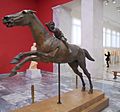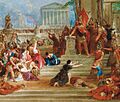Battle of Corinth (146 BC) facts for kids
Quick facts for kids Battle of Corinth |
|||||||||
|---|---|---|---|---|---|---|---|---|---|
| Part of the Achaean War | |||||||||
|
|||||||||
| Belligerents | |||||||||
| Roman Republic | Achaean League | ||||||||
| Commanders and leaders | |||||||||
| Lucius Mummius | Diaeus † | ||||||||
| Strength | |||||||||
| 23,500 infantry 3,300 cavalry |
13,500 infantry 650 cavalry |
||||||||
| Casualties and losses | |||||||||
| Minor | Total | ||||||||
The Battle of Corinth in 146 BC was a very important fight. It happened between the powerful Roman Republic and the Greek city-state of Corinth. Corinth was part of the Achaean League, a group of Greek cities. This battle marked the end of the Achaean War. It also meant that Rome took control of Greece. After the battle, the city of Corinth was completely destroyed by the Romans.
The Romans had moved very quickly since the war started. They had already defeated the main Achaean army at Scarpheia. Then, they took over Boeotia and moved towards Corinth. Even after these losses, the Achaeans refused to give up. They gathered their last army to defend Corinth, their capital. The battle lasted only a few hours. The Achaeans were completely defeated. Their soldiers were killed, captured, or ran away. A few days later, the Romans entered Corinth. On the orders of their general, Mummius, they burned the city. Its people suffered greatly, and many were taken captive. After this, the rest of Greece came under Roman rule.
Contents
Why the War Started
Tensions between Rome and the Achaean League had been growing for many years. A big problem came up between 148 and 146 BC. The Achaeans wanted to include the city of Sparta in their League. Rome did not agree with this. This disagreement caused relations to break down. Some historians say the Achaeans started the fight. Others suggest Rome's desire to expand its power was the cause. It might also have been a simple failure of diplomacy.
The Roman Senate ordered Lucius Mummius to sail to Greece. He was one of the main Roman leaders that year. His job was to stop the Greek revolt. Before Mummius arrived, another Roman general, Quintus Caecilius Metellus Macedonicus, took action. Metellus had just won a war in Macedon. He had a strong, experienced army ready to fight.
Before the Battle
Metellus marched from Macedonia. This area had just become a Roman province. His army defeated an Achaean army led by Critolaos of Megalopolis. This happened at the Battle of Scarpheia. This defeat caused a lot of fear and confusion in Greece. Many cities then surrendered to the Romans.
However, much of the Achaean League decided to keep fighting. This was especially true for Corinth. They rallied around Diaeus. He was chosen as their new leader after Critolaos. They decided to continue the war. They raised money and supplies by collecting harsh taxes. After the battle, the Roman commander moved through Boeotia. He defeated Achaean allies there. He also accepted the surrender of many towns. He showed kindness to these towns. He offered peace to the Achaean League. But Diaeus refused his offer. Diaeus even had politicians who wanted peace arrested or killed.
In 146 BC, Lucius Mummius arrived. He sent Metellus back to Macedonia. Mummius gathered all the Roman forces in the area. He had about 23,000 foot soldiers and 3,500 horsemen. He also had allies from Crete and Pergamum. With this large army, he marched towards Corinth. Corinth was the capital of the Achaean League. The Achaean general Diaeus was there with his army. He had about 14,000 foot soldiers and 600 horsemen. This likely included soldiers who survived the earlier defeat at Scarpheia.
The Battle Begins
The Romans had placed some Italian soldiers as guards. But these guards were not careful. Perhaps they felt too confident because the Achaean army was smaller. This allowed the Achaeans to launch a surprise night attack. They attacked the Roman advance guard's camp. The Achaeans caused many casualties. This made the Achaean soldiers feel more confident.
Mummius then led his own attack. He drove back the Achaean attackers. He pushed them all the way back to their own camp.
Fighting at Corinth
Encouraged by their early success, the Achaeans decided to fight the next day. During the battle, the Achaean foot soldiers bravely faced the Roman legions. But the Achaean horsemen were greatly outnumbered. They did not wait for the Roman cavalry to charge. Instead, they quickly scattered and ran away.
The Achaean foot soldiers, however, held their ground. They fought against the Roman legions even though they were outnumbered. Then, a special group of 1,000 Roman foot soldiers attacked their side. This broke the Achaean lines completely. The defeated Achaeans retreated in a rush. They ran inside the city walls of Corinth. Some Achaeans tried to find safety in Corinth. But no defense was organized. Their leader, Diaeus, fled to Arcadia. There, he took his own life.
The Destruction of Corinth
The Achaean soldiers who survived felt hopeless. Their leader had run away. Most of the people of Corinth also fled the city. The Romans were worried about an ambush. So, they did not enter Corinth until three days after the battle.
Once inside Corinth, the Romans completely destroyed the city. Its people suffered greatly, and many were taken captive. The victorious Roman army took all its treasures and art. According to the historian Polybius, Mummius could not stop his soldiers from doing this. The historian Livy wrote that Mummius did not keep any of the treasures for himself. He praised Mummius for being honest. The complete destruction of Corinth was a harsh act. It was similar to what happened to Carthage in the same year. This was a big change from how Rome had treated Greek cities before.
Polybius also wrote that Roman soldiers were careless. They destroyed valuable works of art. Or they treated them like simple objects for fun. However, they did show respect to the statues of Philopoemen. This was because he was famous. He was also the first Greek ally of Rome. Mummius himself did not know much about art. When he sent priceless statues and paintings to Italy, he gave strange orders. He told the people transporting them that if they lost any, they would have to replace them with new ones. Just like after the Sack of Syracuse, the destruction of Corinth brought many Greek artworks to Rome. This helped spread Greek culture even more. It led to the development of the Greco-Roman world.
What Happened Next
The battle marked the end of Greek resistance. Greece would not see major fighting again for sixty years. The Achaean League was broken up. Greece became part of the new Roman province of Macedonia. Some cities were allowed to keep a little bit of freedom. But Rome now had direct control over mainland Greece.
The city of Corinth did not recover for over a hundred years. There is some evidence that a few people lived there. But it was only when Julius Caesar rebuilt the city in 44 BC. He called it Colonia Laus Iulia Corinthiensis. This was just before his death. After that, Corinth slowly began to become prosperous again.
Images for kids
-
Roman general Lucius Mummius Achaicus in The Sack of Corinth, by Thomas Allom (detail)
See also
 In Spanish: Batalla de Corinto para niños
In Spanish: Batalla de Corinto para niños





